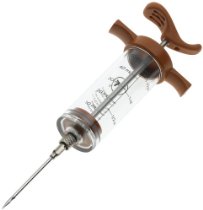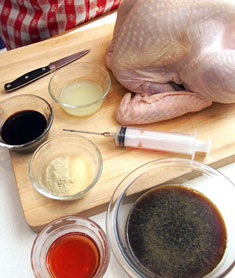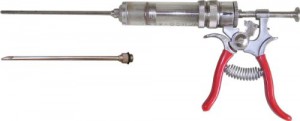There are four basic methods of adding flavor to meat or poultry before cooking: brining, rubbing, marinating and injecting. Feeling a little squeamish about sticking a big needle into your food? Here are some tips that might help. I promise, it won’t hurt a bit.
When you purchase meat, try to avoid meat that has been “enhanced,” which means it’s already been injected with a salt and water solution. Not only do you pay for that injected weight, you also can’t control the flavor of the finished product. If you have to use an “enhanced” product, you don’t want to brine it again, as it will be too salty.
Rubs are a combination of herbs and spices that is literally “rubbed” onto the surface of the meat before cooking. Because the rub is only on the surface, it doesn’t really penetrate into the meat.
Marinating is soaking the meat in a water or stock solution containing herbs, spices, salt and usually sugar. As with rubs, marinating doesn’t penetrate very far into the meat.
Injecting is the way to get flavor into the meat, especially with large cuts such as a pork shoulder or brisket. To inject the meat with flavoring agents and liquid, you’ll need a kitchen syringe (also called a Cajun injector)… it’s basically a heavy plastic syringe with a large bore needle, usually about three to four inches long. You can find an inexpensive injector like the one at left at the Burnin’ Love BBQ Store. The snazzy, more expensive SpitJack injector with two tips can also be found at Burnin’ Love BBQ Store.
Any time you use an injection for meat or poultry, you’ll want to give the meat some time to absorb the flavors before cooking; an hour or so in the refrigerator should be fine. I also recommend using your favorite rub, along with the injected flavoring. Be sure to inject the solution deep into the meat, depressing the plunger while slowly pulling the needle out. Repeat in several spots. Don’t worry if quite a bit leaks out during cooking. Enough will stay in the meat to provide flavor.
There are scores of injection recipes on the web, but I have a few favorites that I highlighted in my book Mastering Barbecue. Here are some recipes for various injections:
Injection Formula for Turkey or Other Poultry
2 ounces liquid garlic
1 ounce liquid crab boil
2 ounces of your favorite hot sauce
1/2 cup unsalted butter, melted
2 ounces onion juice
2 ounces Worcestershire sauce
2 tablespoons Cajun seasoning (home-made preferred)
Combine all the ingredients in a mixing bowl. Inject one ounce of the solution per pound into the breast, thigh and legs.
Injection Formula for Pork
2 cups pure apple cider
2 1/2 cups pork stock
1/2 cup apple cider vinegar
1/4 cup Worcestershire sauce
2 tablespoons unsalted butter, melted
1 tablespoon coarse kosher salt
Melt the butter in a small saucepan and add the remaining ingredients; stir well to combine. Cool and inject throughout the pork shoulder.
Rub/Injection Formula for Beef
Usually for beef, such as a brisket, I like to use a rub along with some liquid for injecting.
Here’s my basic brisket rub:
1/4 cup dark brown sugar
1/4 cup cracked black pepper
1/4 cup sweet smoked paprika
2 tablespoons granulated garlic
2 tablespoons coarse kosher salt
1 tablespoon dry mustard
1 tablespoon onion powder
2 teaspoons ground cayenne pepper
Combine all the ingredients in a small bowl and stir to incorporate. Take 1/4 of the rub and combine it with 1/2 cup apple cider vinegar and 1/4 cup olive oil. Strain the liquid and inject into the brisket. Use the remaining rub to coat the brisket before cooking.
Latest posts by Mike Stines (see all)
- Winter Shrimp Festival: Comfort of the Sea - 11/11/2022
- Singapore Fried Prawns with Dried Chile - 10/31/2022
- Planked Trout with Cayenne and Herbs - 08/02/2022









